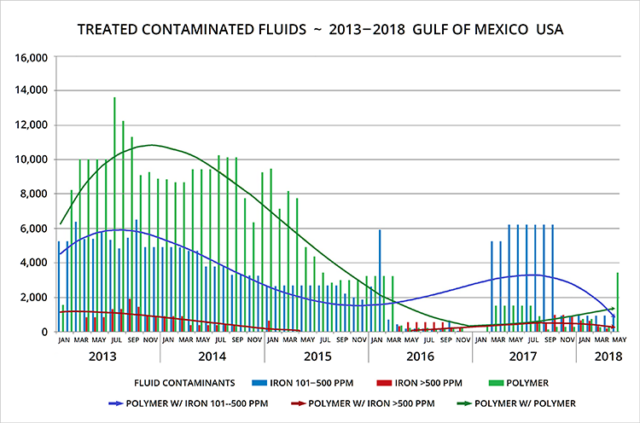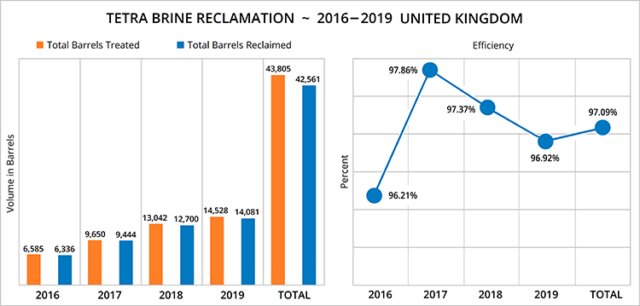One of the biggest challenges facing operators in the North Sea and other deepwater regions is finding a sustainable alternative to cesium formate brines. Since the 1990s, cesium formate has become the necessary choice among operators because it’s relatively benign to the environment and can be formulated for the high densities and temperatures needed for deepwater operations—but it’s also very expensive and is a finite resource available from a few deposits. According to the U.S. Geological Survey, in 2022 the price for 25 grams of 98% cesium formate averaged $46.10.[1] You don’t have to be a drilling engineer to know that 25 grams is only a drop in a barrel—and it takes hundreds of barrels of fluid to drill and complete a well.
Problem Solved
Fortunately, there is an alternative: TETRA Neptune multi-use fluid. Unique in the industry, the fluid is super versatile, formate-free, and can be formulated at densities from 11.6 lb/gal to 17.5 lb/gal with lower operating temperatures than standard brines. The fluid has a stable alkaline pH with no risk of producing corrosive formic acid, and it’s thermally stable, with true and pressurized crystallization temperatures (TCT and PCT) that can hold up to the harsh conditions of deepwater operations without crystallization.
The table here shows six formulations of both divalent and monovalent TETRA Neptune fluid in densities ranging from 11.6 to 17.5 lb/gal.
| CHEMISTRY | VALENCY | DENSITY lb/gal |
| CaBr2 | Divalent | 14.5–14.9 |
| High-Density CaCl2 | Divalent | 11.6–12.0 |
| High-Density NaBr | Monovalent | 12.5–13.1 |
| High-Density CaBr2 | Divalent | 14.5–15.4 |
| Extra-High-Density NaBr | Monovalent | 12.5–15.4 |
| Extra-High-Density CaBr2 | Divalent | 14.5–17.5 |
Versatility
TETRA Neptune multi-use fluid can be used as a completion fluid, a reservoir drill-in fluid, a barrier fluid, a packer fluid, a suspension fluid, a base for pills and slugs, in the brine phase of non-aqueous fluids in workovers, and for use as a control line/pad fluid and other tasks. What other fluid can do that? This versatility makes Neptune very cost-efficient, enabling the use of a single batch for different operations, which not only reduces costs but also simplifies logistics and handling needs.
The fluid’s versatility and effectiveness are field proven. Introduced in 2015, TETRA Neptune has been used in the Gulf of Mexico as a completion brine, packer fluid, and the base for wellbore treatment pills with tremendous success.
Recently, the fluid saw its first use in an intervention and abandonment operation in the North Sea, in waters 80 meters deep at a true vertical depth of more than 4,000 meters. The job included a blowout preventer test at 10,000 psi with a true crystallization temperature below −30.5ºC. Showcasing its versatility, the 14.7-lb/gal clear brine fluid doubled as suspension fluid and the bases for wellbore displacement and viscosified pills, performing flawlessly with zero HSE incidents.
TETRA Neptune fluid is ideal for use as a reservoir drill-in fluid as well. Pairing the high-density monovalent formulation with 50 pounds-per-barrel of ground marble can yield a fluid density of 15.8 lb/gal.[2] The customized fluid reduces the potential for reservoir damage, and afterward it can be converted to clear brine for reuse in the completion phase, thereby reducing cost, time, and logistics.
The unique TETRA fluid can also be used in the formulation of solids-free invert emulsions, when non-aqueous fluids are needed and the presence of solid weighting agents are undesirable. Substituting 17.5-lb/gal Neptune for calcium bromide, for example, can yield an emulsion with a density as high as 12.9 lb/gal.
So, as one can see, TETRA Neptune multi-use fluid may not be a suitable dessert topping or floor wax (don’t try that at home!), but it is super versatile for the drilling and completion of oil and gas wells—and this versatility means cost-efficiency and high performance.
Sustainability
TETRA Neptune also fills the need for a sustainable alternative. With a smaller carbon footprint than other high-density fluids, its ingredients are regionally sources, plentiful, and environmentally safe. It delivers simplified logistics as well. To formulate it for the specific needs of your applications requires no special mixing, handling, or storage at rig sites or aboard marine vessels, nor does it require zero-discharge equipment. The proprietary fluid has environmental approval for use in the North Sea, and it can be reclaimed for subsequent reuse.
What Are You Waiting For?
The time for using TETRA Neptune fluid in your operations has come. Consider its versatile applications and beneficial features:
Applications
- Completion fluid
- Reservoir drill-in fluid
- Packer fluid
- Suspension fluid
- Base for wellbore treatment pills
- Pad/control line applications
- Base for non-aqueous invert emulsions
Beneficial Features
- Densities ranging from 11.6 to 17.5 lb/gal
- Thermally stable with excellent TCT and PCT
- Divalent and monovalent formulations
- Stable alkaline pH
- No risk of forming corrosive formic acid
- More versatile than cesium formate and other brines
- Lower cost than cesium formate
- Environmentally friendly
- More sustainable than other brines
Whether you’re operating in the North Sea, the Gulf of Mexico, the South Atlantic, or onshore, this versatile fluid is a sustainable alternative to cesium formate that will deliver economic and operational value.
Endnotes
[1] See “MCS2023-Cesium” at the USGS website. The 2022 price reflects an 8% increase over $42.60 in 2021. Cesium is not rare in the absolute sense, but it is sourced from very few mines around the world—primarily a single mine in Canada—and its reactive nature complicates extraction, purification, and storage. The element is an alkali metal that is highly reactive and would melt in hand if it did not first react with ambient moisture and ignite.
[2] Both monovalent and divalent fluids can be used for reservoir drill-in, but the latter have limitations. A divalent brine’s cations can react with the formation water’s anions to create insoluble solids capable of clogging reservoir pores, and monovalent brines are more amenable to the starches and polysaccharides added to increase viscosity for fluid-loss control.






